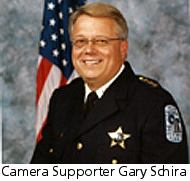8/31/2009
Illinois City Forgets Lesson of 1992 Photo Enforcement ReferendumPhoto enforcement caused a voter revolt in Batavia, Illinois in 1992. City leaders want to try it again anyway.

Despite the clear message sent by voters in 1992, the city of Batavia, Illinois is busy pursuing a return to the use of photo enforcement. Police Chief Gary J. Schira made a sales pitch to the city council last month on behalf of the private companies that operate red light camera systems, hoping to add the lucrative program to his budget. Minutes from a Government Services Committee meeting on November 19, 2008 described the intention of city leaders:The city leaders dipped their toes in the water of automated ticketing more than a decade ago for the same reason. They regretted their decision. Toward the end of 1991, Batavia had finalized a deal with Traffic Monitoring Technologies (TMT), which is now the red light camera and speed camera firm American Traffic Solutions (ATS). This company would operate a mobile speed camera van on Kirk Road, a four-lane highway with a 45 MPH speed limit. At the time, this route happened to be experiencing its lowest accident rate in recent memory.
- "Ald. Barnard wanted further details on potential revenue from the red light camera enforcement before deciding whether that would be appropriate for Batavia."
- "Ald. Volk opined if red light enforcement cameras were placed in Batavia a majority of revenue would go to Kane County rather than Batavia."
- "Ald. Vance disagreed with Ald. Nelson and felt that red light enforcement cameras would aid in providing revenue to Batavia as well as help with road safety issues."
- "Mayor Schielke stated he believed red light enforcement camera revenues from Randall Road would be shared with Kane County."
- "Police Chief Schira added that potentially the revenue that could be made for the city is $42,000 on approach per year... Schira ended by stating red light enforcement camera revenue is worth exploring."
Groups like the National Motorists Association stepped in to oppose the program, but Alderman David Waters, the main proponent of cameras, banned anyone who did not live within the city limits from speaking at public meetings on the issue. He did so even though non-residents were the primary target for the photo radar program. Ninety-four percent of the speeding tickets issued by human police officers on Kirk Road went to outsiders.
Batavia resident Yvonne Dinwiddie was the primary organizer of the local opposition. After forming the group Citizens Protecting Your Rights, she helped gather signatures on a petition to give voters a say in a non-binding advisory referendum on speed cameras. By December 1466 had signed, even though only 1000 signatures were needed.
On March 17, 1992, two-thirds of eligible voters showed up at the polls to answer the question: "Should the City of Batavia use photo-radar devices to photograph motor vehicles and/or drivers for the purpose of enforcing speed limits?" A total of 63.3 percent said no; just 36.7 said yes. Voters sent a second message as David Waters met with a crushing defeat in the Republican primary at the hands of Douglas Weigand.
Still, the cameras were not dead yet. Led by Waters, a city council committee on March 30 voted 4 to 1 to defy the voters and recommend keeping the camera program. Officials blamed the public for being "misinformed." After local activists started to work on recall petitions, the council reluctantly accepted the results. On April 20, the council voted 9 to 1 to kill the photo radar program for good. No actual tickets were ever mailed by the program, although it did begin issuing warning citations on February 17.
The overwhelming referendum result had a chilling effect on plans to install speed cameras throughout the state. Nearby cities like Wheaton and Elgin immediately dropped speed camera plans that were nearly final. Elgin had even anticipated photo radar profit in its 1992 budget document. Red light cameras have since spread to about fifty suburban Illinois jurisdictions after then-Governor Rod Blagojevich (D) signed legislation in 2005 authorizing automated ticketing for the benefit of high-powered lobbyists for Australia's Redflex and the UK-Israeli firm Redspeed.


